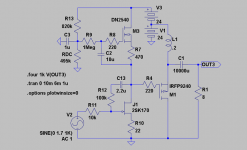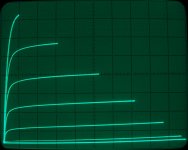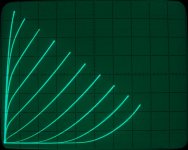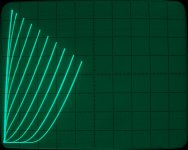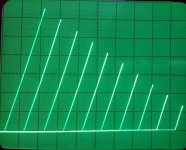When you look at the circuit, you have to realize that this
is a mild form of negative feedback. It points to a
possible equivalence between low amounts of negative
feedback and the effect of plate-cathode voltage on the
transconductance figure of a triode.
When you work a load line so as to cancel these two
distortions, the result is lowered 2nd harmonic but the
appearance of 3rd and other harmonics, similar to
Baxandall's analysis of negative feedback.

is a mild form of negative feedback. It points to a
possible equivalence between low amounts of negative
feedback and the effect of plate-cathode voltage on the
transconductance figure of a triode.
When you work a load line so as to cancel these two
distortions, the result is lowered 2nd harmonic but the
appearance of 3rd and other harmonics, similar to
Baxandall's analysis of negative feedback.
I was browsing through Horowitz and Hill (a little light after-
work reading) and noticed the "Fet linearizing" circuit which
is used to straighten out the characteristics of fets used as
variable resistors. It is another example of this technique,
but it's used to straighten out the curves at low voltages.

work reading) and noticed the "Fet linearizing" circuit which
is used to straighten out the characteristics of fets used as
variable resistors. It is another example of this technique,
but it's used to straighten out the curves at low voltages.
Reread Linsley-Hoods LINIAC article from -71 the other day and saw some similarities to what have been delt with here.
If we combine the Schaded 2SK170 with a "voltagecontrolling" gyrator and a SF we are there.
One could of course take the NFB from the output but does a SF really need more NFB?
Using a P-channel output device there is no need for insulation against the heatsink as drain is to ground.
RDC is used to achieve symmetrical clipping.
Unfortunately the gyrator needs additonal voltage to work. If instead a choke was used the 24V would be enough. The gyrator FET doesn´t need to be depletion, anything with high Gm will do.
If we combine the Schaded 2SK170 with a "voltagecontrolling" gyrator and a SF we are there.
One could of course take the NFB from the output but does a SF really need more NFB?
Using a P-channel output device there is no need for insulation against the heatsink as drain is to ground.
RDC is used to achieve symmetrical clipping.
Unfortunately the gyrator needs additonal voltage to work. If instead a choke was used the 24V would be enough. The gyrator FET doesn´t need to be depletion, anything with high Gm will do.
Attachments
Last edited:
Reread Linsley-Hoods LINIAC article from -71 the other day and saw some similarities to what have been delt with here.
If we combine the Schaded 2SK170 with a "voltagecontrolling" gyrator and a SF we are there.
One could of course take the NFB from the output but does a SF really need more NFB?
Using a P-channel output device there is no need for insulation against the heatsink as drain is to ground.
RDC is used to achieve symmetrical clipping.
Unfortunately the gyrator needs additonal voltage to work. If instead a choke was used the 24V would be enough. The gyrator FET doesn´t need to be depletion, anything with high Gm will do.
Lars, how was your test result?
I guess, that the M100A (M 100 A, M100) from "Esoteric Audio Research" (EAR, Tim Paravicini) could be a commercial product with similar circuit topology inside - please go to the weblinks
hi-fi, home cinema and multi-room audio and video specialists in Poole, Dorset | stoneaudio.co.uk
http://www.savantaudio.com/earm100.html
EAR/Yoshino 834T Integrated Amplifier Review By Dick Olsher
M100A
the detailed description is to find by the last weblink, but only in German
perhaps anybody has a detailled schematic diagram and photos from inside of this power OT-SE power amplifier
Quote from
Music, Sound and Personalities: 2001 CES by Dave Glackin
The Best Un-Solid-State-Like Solid State Electronics (Tie) were from Tim deParavicini of Esoteric Audio Research. Tim was demonstrating the M100 A single-ended solid-state Class A transformer-coupled 100W monoblock power amps with his model 312 solid state transformer-coupled preamp ($35,000 and $18,000, respectively). Speakers were the Kharma Ceramic 1 Limited Edition. Solid state is quite a departure for Tim, but the beautiful sound that he was getting spoke for itself. It didn't sound like solid state or tubes, but it did sound an awful lot like music. You can contact E.A.R. USA via phone at (562) 422-4747 or via fax at (562) 422-6577 in Long Beach, California. (That's so retro.) You'll find Kharma at www.kharmausa.com.
Quote from
Paravicini M100A Twin Tower2
Paravicini M100A First Solid State Single Ended Power Amplifier The M100 monoblock power amplifier, EAR/Yoshino’s second venture into solid state. Tim de Paravicini has burned the rulebook as usual, producing a pure Class A, single ended, 100W monster which combines awesome sonic authority with exquisite filigree detail. Unique circuit design - including one of Tim’s legendary output transformers - ensures the perfect match between the traditional audio virtues of valves and transistors. Superb construction, great looks, novel heatsinks (no perilous sharp edges - and no noisy fans!), high reliability, extraordinary pride of ownership. Discerning audiophiles prepared to lose some serious weight in the wallet department will need little persuading. Specifications Maximum output: Frequency response (at 1W output): Power bandwidth: Input impedance: Damping factor: Sensitivity: Residual noise (volume at minimum): Distortion: Max. Size (overall, excluding control knobs): Weight (nett): 100W (28VRMS on 8 ohm terminals) -3dB at 3Hz, 40kHz -3dB at 20Hz, 40kHz 47kohm 8 1V for full output 0.5mV 2% at full power W 240mm, D 500mm, H 570mm 70kg Yoshino Ltd. Coombe Grove Farm, Ermine Way, Arrington, Cambs. SG8 0AL Tel No. +44 (0) 1223 208877, Fax No. +44 (0) 1223 208761
Are there a schematic available in the meantime?
Measuring results are to find here:
EAR/Yoshino M100A monoblock power amplifier Measurements | Stereophile.com
and the listening test results here:
EAR/Yoshino M100A monoblock power amplifier | Stereophile.com
Hello revintage. A bjt has pentode-like characteristic curves. Will your methodology of this post also apply to a bjt; meaning a bjt sounding like a triode?So what happens if we adapt what Schade taught us to a JFET as buffer?
Works like wonders!
Zout below 200ohms, together with low THD and acceptable bandwith (-3dB at well over 200kHz). Zin chosen to 10kohm. With 22kohm/91k bandwith is 100kHz.
But don´t try to a volume-pot at the input! Must be fed from a lowZ source.
Brgds.
Just for fun, I traced some curves for the NTE451 JFET that show the effect of parallel feedback. It indeed works as advertized (on the curve tracer).
Link to video of curves using a potentiometer to vary the amount of feedback
Link to video of curves using a potentiometer to vary the amount of feedback
Attachments
Thank you avincenty for your interesting results. Did you convert a run of the mill bjt to a new and linear solid state triode? What is the relevance of "extremely linear" in application? I hope it is good if it sounds triodish?A BJT
The JFET curves look more like a real triode. The BJT looks extremely linear though.
Yes, a 2N3904.
Not sure about how it would sound. I am not really a solid state person, more into tubes, but I'd think that it would have much less distortion and won't have a tube sound.
I think the JFET will have more even harmonics like a triode and would sound more toobie.
Not sure about how it would sound. I am not really a solid state person, more into tubes, but I'd think that it would have much less distortion and won't have a tube sound.
I think the JFET will have more even harmonics like a triode and would sound more toobie.
Thanks avincenty for the interesting video. Creative, instructional and showed that one gets a tweakble solid state triode performance! Was feedback from drain to gate increasing as a function of time? Do you have another video like it for bjt to understand its behavior?. Best regards.Just for fun, I traced some curves for the NTE451 JFET that show the effect of parallel feedback. It indeed works as advertized (on the curve tracer).
Link to video of curves using a potentiometer to vary the amount of feedback
Thank you avincenty.I did not video the BJT but the behavior is the same. The more feedback the more vertical the curves get.
avincenty: Schade feedback concerns itself with a current source amp; also called a transconductance amp [TCA]. Please take a look at the F1 schematic in its service manual at www.firstwatt.com. It is a differential TCA. Mr. Pass used feedback from the drain to the gate of each of the two amplifying MOSFETs. Clearly Schade feedback [inadvertent or not]; which may have sweetened the performance of this amplifier in favor of a triodish sound. Best regards.Thank you avincenty.
Looks more like voltage divider bias to me. (F1)
It is a voltage divider bias. Please note that it also has the signature of Schade feedback of at least the following 3 requirements:
- MOSFET Q1 [for example] is a current source amplifier.
- The Gate of Q1 is a summing junction of 2 signals which are out of phase.
- A feedback resistor is used between the Drain and the Gate of Q1. It generates the out of phase signal which sums with the in-phase input signal at the Gate.
I am a newbee at this fascinating application and learning it . I hope that I am not out of line in my observations. I appreciate your feedback and that of others like wrenchone and Zen Mod. I understand that SIT is a voltage and not a current source amplifier. Thus, it it unclear to me whether Schade Feedback is useful or needed in it to make it behave "more or less triodish" than it already is. Best regards.Sounds like you've got it all figured out. I'll just move on.
- Home
- Amplifiers
- Pass Labs
- O.H. Schade (1938) meets mosFET
